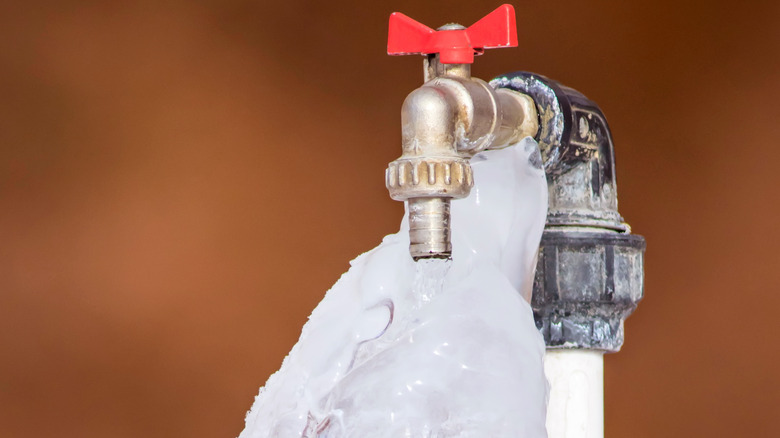What are your thoughts on Prevent Frozen Pipes ?

Winter can wreak havoc on your pipes, particularly by freezing pipelines. Right here's exactly how to prevent it from taking place and what to do if it does.
Intro
As temperatures drop, the danger of frozen pipelines increases, possibly causing expensive repairs and water damages. Understanding how to avoid icy pipelines is vital for homeowners in cool climates.
Avoidance Tips
Insulating vulnerable pipelines
Cover pipelines in insulation sleeves or utilize warm tape to safeguard them from freezing temperatures. Concentrate on pipes in unheated or outside locations of the home.
Heating techniques
Maintain indoor areas appropriately heated up, specifically locations with pipes. Open up closet doors to permit cozy air to circulate around pipelines under sinks.
Just how to recognize frozen pipelines
Try to find lowered water circulation from faucets, unusual smells or noises from pipes, and visible frost on subjected pipelines.
Long-Term Solutions
Structural changes
Take into consideration rerouting pipelines away from exterior wall surfaces or unheated locations. Add extra insulation to attic rooms, cellars, and crawl spaces.
Upgrading insulation
Invest in high-grade insulation for pipes, attic rooms, and walls. Appropriate insulation aids maintain constant temperatures and lowers the danger of icy pipelines.
Protecting Exterior Pipes
Garden pipes and outdoor faucets
Disconnect and drain yard tubes before winter months. Install frost-proof faucets or cover outdoor taps with protected caps.
Recognizing Icy Pipes
What causes pipelines to ice up?
Pipelines freeze when revealed to temperature levels below 32 ° F (0 ° C) for prolonged durations. As water inside the pipelines freezes, it broadens, putting pressure on the pipeline wall surfaces and possibly triggering them to burst.
Threats and damages
Frozen pipelines can bring about water interruptions, building damage, and expensive repairs. Ruptured pipes can flooding homes and cause comprehensive structural damages.
Indications of Frozen Pipeline
Determining icy pipelines early can prevent them from breaking.
What to Do If Your Pipes Freeze
Immediate activities to take
If you presume icy pipes, keep taps available to ease stress as the ice thaws. Make use of a hairdryer or towels taken in hot water to thaw pipes gradually.
Final thought
Stopping frozen pipes needs proactive procedures and fast actions. By understanding the reasons, signs, and safety nets, home owners can secure their plumbing during cold weather.
5 Ways to Prevent Frozen Pipes
Drain Outdoor Faucets and Disconnect Hoses
First, close the shut-off valve that controls the flow of water in the pipe to your outdoor faucet. Then, head outside to disconnect and drain your hose and open the outdoor faucet to allow the water to completely drain out of the line. Turn off the faucet when done. Finally, head back to the shut-off valve and drain the remaining water inside the pipe into a bucket or container. Additionally, if you have a home irrigation system, you should consider hiring an expert to clear the system of water each year.
Insulate Pipes
One of the best and most cost-effective methods for preventing frozen water pipes is to wrap your pipes with insulation. This is especially important for areas in your home that aren’t exposed to heat, such as an attic. We suggest using foam sleeves, which can typically be found at your local hardware store.
Keep Heat Running at 65
Your pipes are located inside your walls, and the temperature there is much colder than the rest of the house. To prevent your pipes from freezing, The Insurance Information Institute suggests that you keep your home heated to at least 65 degrees, even when traveling. You may want to invest in smart devices that can keep an eye on the temperature in your home while you’re away.
Leave Water Dripping
Moving water — even a small trickle — can prevent ice from forming inside your pipes. When freezing temps are imminent, start a drip of water from all faucets that serve exposed pipes. Leaving a few faucets running will also help relieve pressure inside the pipes and help prevent a rupture if the water inside freezes.
Open Cupboard Doors
Warm your kitchen and bathroom pipes by opening cupboards and vanities. You should also leave your interior doors ajar to help warm air circulate evenly throughout your home.

We had been shown that editorial about Winter Plumbing Precautions: Preventing Frozen Pipes through someone on another web page. If you enjoyed our blog post if you please do not forget to pass it around. Thanks so much for your time spent reading it.
Call Today